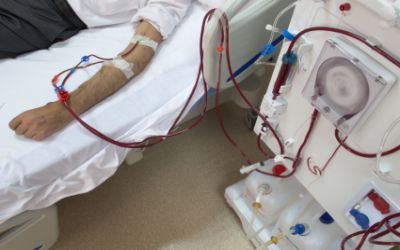Experts Address the Urgent Need to Prevent Infections in Hemodialysis Facilities

Patients with kidney failure who are treated with hemodialysis are at substantially increased risk of life-threatening infections. A feature article and a series of Perspectives articles in the Clinical Journal of the American Society of Nephrology (CJASN) provide important information on infections and their prevention in patients undergoing hemodialysis. The articles are part of an initiative called Nephrologists Transforming Dialysis Safety (NTDS).
Controlling infectious threats to patients and staff in healthcare facilities is an urgent need. For kidney failure patients, infection-related mortality and hospitalization rates during the first year of receiving hemodialysis are now equal to or exceed events related to cardiovascular disease, the leading cause of death in the overall hemodialysis population. In October 2016, the Centers for Disease Control and Prevention (CDC) and the American Society of Nephrology jointly announced the NTDS initiative targeted at reducing infectious complications among patients receiving in-center hemodialysis.
“Preventable infections in dialysis patients are the leading cause of hospitalization, and second only to cardiovascular disease as the cause of death. And while overall mortality has fallen over the past decade, infection-related mortality has changed little compared with improving cardiovascular outcomes,” said Alan Kliger, MD, Chair of NTDS. “NTDS is working to target zero preventable infections by promoting use of evidence-based CDC published best practices, encouraging communication with state and federal Hospital-Acquired Infection experts, and spreading the word on the need to stop infections.”
The first perspective article in CJASN looks at trends in infection-related mortality among hemodialysis patients, as well as the types of infections that dialysis patients are contracting. It notes that although hospitalizations of patients on dialysis have declined, the persistence of life-threatening bloodstream infections requires a greater focus on prevention. The lack of progress in reducing pneumonia-influenza hospitalization is especially troubling.
A second article addresses multidrug-resistant organisms, including methicillin- resistant Staphylococcus aureus, vancomycin- resistant enterococci, and multidrug-resistant gram-negative bacteria in patients on dialysis. The threat of such multidrug-resistant organisms is especially high for patients on maintenance hemodialysis, and studies are needed to provide a better understanding of the transmission dynamics of these organisms within dialysis facilities.
A third article focuses on preparing dialysis units for outbreaks of emerging infectious diseases, such as Ebola virus Disease (EVD). During the 2014-2015 EVD outbreak, the Centers for Disease Control and Prevention believed it unlikely that a person with EVD would have presented to ambulatory settings such as an outpatient hemodialysis center. Yet the agency recommended that ambulatory care centers be prepared for such an occurrence due to its potential catastrophic consequences. As a result, it is imperative that hemodialysis units have written plans for triaging patients during outbreaks.
A fourth article emphasizes the importance of adhering to recommended infection control practices, and it highlights the important leadership role of nephrologists, especially medical directors, in preventing infections in hemodialysis facilities.
A feature article in the journal notes that NTDS is reconceptualizing the infection problem in the context of the complexity of healthcare systems and organizational behavior. Because dialysis infections result from a complex system of interactions between caregivers, patients, dialysis organizations, and the environment, attempts to address infections by focusing on one element in isolation often fail. The paper explores the systemic factors contributing to the ongoing dialysis infection crisis in the United States and the role of nephrologists in instilling a culture of safety in which infections can be anticipated and prevented.
The articles are titled:
“Urgent: Stop Preventable Infections Now,”
“Addressing the Problem of Multidrug-Resistant Organisms in Dialysis,”
“What We Learned from Ebola,”
“100% Use of Infection Control Procedures in Hemodialysis Facilities,” and
“Systems Thinking and Leadership:?How Nephrologists Can Transform Dialysis Safety to Prevent Infections.”
They will appear online at http://cjasn.asnjournals.org/ on March 22, 2018.
Source: American Society of Nephrology (ASN)
Robust infectious disease surveillance, including rapid subtyping of influenza A, is essential for early detection, containment, and public health reporting of novel viral threats.